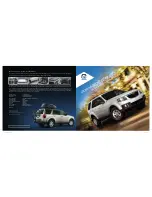
of a collision. In the first deployment stage,
the front airbag is filled with enough propel-
lant gas to reduce the risk of injuries. The
front airbag is fully deployed if a second
deployment threshold is exceeded within a
few milliseconds.
The belt tensioner and airbag triggering
thresholds are variable and are adapted to the
rate of deceleration or acceleration of the
vehicle. This process is pre-emptive in nature.
The triggering process must take place in
good time at the start of the collision.
i
Airbags are not deployed in all types of
accidents. Also, not all airbags are
deployed together in an accident. The dif-
ferent airbag systems work independently
of each other.
How the airbag system works is deter-
mined by the severity of the collision detec-
ted, especially the vehicle deceleration or
acceleration, and the apparent type of acci-
dent:
R
head-on collision
R
side impact
R
overturn
The rate of vehicle deceleration or accelera-
tion and the direction of the force are essen-
tially determined by:
R
the distribution of forces during the colli-
sion
R
the collision angle
R
the deformation characteristics of the vehi-
cle
R
the characteristics of the object with which
the vehicle has collided
Factors which can only be seen and measured
after a collision has occurred do not play a
decisive role in the deployment of an airbag,
nor do they provide an indication of airbag
deployment.
The vehicle may be deformed significantly,
e.g. the bonnet or the wing, without an airbag
being deployed. This is the case if only parts
which are relatively easily deformed are affec-
ted and the rate of deceleration is not high.
Conversely, airbags may be deployed even
though the vehicle suffers only minor defor-
mation. This is the case if, for example, very
rigid vehicle parts such as longitudinal body
members are hit, and sufficient deceleration
occurs as a result.
Airbags
Important safety notes
Airbag deployment slows down and restricts
the movement of the vehicle occupant.
If the airbags are deployed, you will hear a
bang and a small amount of powder may also
be released. Only in rare cases will the bang
affect your hearing. The powder that is
released generally does not constitute a
health hazard. The
6
SRS warning lamp
lights up.
The airbag installation locations are identified
by the AIRBAG symbol.
G
WARNING
Airbags provide additional protection; they
are not, however, a substitute for seat belts.
Observe the following notes to reduce the risk
of serious or even fatal injury caused by airbag
deployment:
R
all vehicle occupants – in particular, preg-
nant women – must wear their seat belt
correctly at all times and lean back against
the backrest, which should be positioned
as close to the vertical as possible. The
head restraint must support the back of the
head at about eye level.
R
always secure children less than 1.50 m tall
and under 12 years of age in suitable child
restraint systems.
R
all vehicle occupants must select a seat
position that is as far away from the airbag
as possible. The driver's seat position must
allow the vehicle to be driven safely. The
driver's chest should be as far away from
42
Occupant safety
Safet
y
Содержание CLS 2011
Страница 2: ......
Страница 3: ......
Страница 5: ......
Страница 29: ...26...
Страница 41: ...38...
Страница 93: ...90...
Страница 107: ...104...
Страница 297: ...294...
Страница 298: ...Useful information 296 Loading guidelines 296 Stowage areas 296 Features 306 295 Stowing and features...
Страница 320: ...Useful information 318 Engine compartment 318 Maintenance 322 Care 324 317 Maintenance and care...
Страница 371: ...368...
Страница 387: ...384...
Страница 388: ......
Страница 389: ......
















































